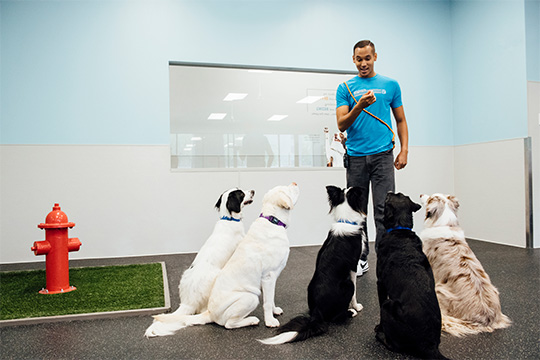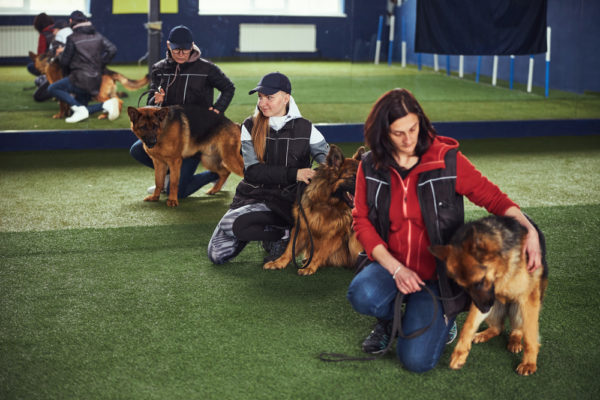Top-Rated Dog Training Rochester NY for All Breeds and Skill Levels
Top-Rated Dog Training Rochester NY for All Breeds and Skill Levels
Blog Article
Newbie's Guide to Successful Pet Dog Training at Home
Efficiently educating a pet at home needs a nuanced understanding of canine actions and efficient interaction techniques. Developing clear training objectives, utilizing high-quality benefits, and keeping consistency across family participants are essential components. Furthermore, integrating training into everyday regimens can boost both engagement and retention. Numerous newbie instructors experience obstacles that might prevent progress. To browse these complexities effectively, it's important to discover several crucial facets that can transform your method and result in a harmonious relationship with your animal. What fundamental principles should every novice grip to ensure success?
Recognizing Pet Dog Actions
Recognizing canine actions is important for effective training and fostering a harmonious connection between humans and their canine companions - Puppy Training. Canines interact primarily via body language, vocalizations, and facial expressions, making it critical for proprietors to translate these signals accurately. Identifying habits such as tail wagging, growling, or shrinking can give understandings right into a canine's emotional state and objectives
In addition, understanding the natural reactions of canines, such as their pack mindset, aids proprietors develop management roles within the family. This is important for developing a structured setting where canines really feel safe and secure and are extra receptive to training. Pets are also affected by their socializing experiences; early direct exposure to different environments, individuals, and various other animals can significantly shape their actions later in life.
Typical behavioral concerns, such as aggressiveness, anxiousness, or extreme barking, typically come from misunderstandings or unmet needs. Observing and addressing these problems quickly can avoid acceleration and make sure a positive training experience. By fostering a deep understanding of pet dog habits, owners can tailor their training techniques to fit their canine buddies, inevitably resulting in a happy and well-behaved family pet.

Essential Training Devices
A well-appointed training area can substantially improve the effectiveness of dog training in the house. Necessary training devices guarantee that both the pet and the instructor can involve in efficient sessions that foster understanding and bonding.

Investing in a durable leash and a comfortable, well-fitting collar or harness is important for security and control. These devices aid establish limits and make sure the pet dog remains protected during training. Additionally, an assigned training area, free from interruptions, aids concentration for both the dog and the instructor.
Training aids such as training pads, cones, or dexterity equipment can additionally boost the experience by presenting range and difficulties. Having a note pad or digital application for tracking progress can be vital, enabling you to note successes and areas for improvement. Utilizing these important tools will certainly our website develop a positive training environment and lay the structure for reliable understanding.
Developing a Training Routine
Developing a regular training routine is vital for efficient pet dog training in the house. A well-structured regular not only aids in enhancing preferred behaviors but additionally supplies your dog with a complacency and predictability. To produce an effective training regular, begin by recognizing certain training goals, such as basic commands, chain walking, or housebreaking.
Choose an assigned time each day for training sessions, preferably when your canine is alert and receptive. Procedure must be brief, around 5 to 15 minutes, to keep focus and stop fatigue. Uniformity in timing and atmosphere will certainly improve your canine's learning experience.
Integrate training into day-to-day tasks to enhance skills. As an example, technique commands throughout walks or mealtime, which incorporates finding out into natural regimens. Furthermore, continue to be adaptable and adjust the routine as needed, suiting your dog's energy levels and mood.
Positive Reinforcement Methods

When implementing favorable reinforcement, it is important to pick benefits that are motivating for your pet. High-value treats, such as tiny pieces of poultry or cheese, can be particularly reliable during training sessions. Furthermore, varying the incentives can maintain your pet dog's interest and interest.
Beginning with easy commands, like "rest" or "remain," and slowly development to more complicated jobs. Consistency is crucial; guarantee that all household members utilize the very same commands and reward systems to prevent complication.
Furthermore, it is essential to remain patient and prevent aggravation. Pet dogs, like human beings, learn at their very own rate. By fostering an encouraging training environment through positive reinforcement, you can enhance your canine's knowing experience while reinforcing the bond in between you and your furry buddy, laying the foundation for effective training outcomes.
Common Training Challenges
While training a canine in your home can be a fulfilling experience, it typically features a collection of usual obstacles that can examine both perseverance and consistency. One common concern is interruption. Pet dogs might end up being quickly averted by noises, activities, and even fragrances in their atmosphere, making it tough to preserve their focus during training sessions.
Another challenge is inconsistency in commands and support. It can impede and perplex the dog progress if household members utilize different hints or incentives. Developing click to find out more a unified method is essential for effective interaction.
Additionally, canines can experience frustration or tension, specifically if they do not comprehend what is expected of them. This can bring about unfavorable behaviors, such as barking or eating.
Finally, the timing of support is vital. Delayed incentives can diminish the effectiveness of positive support, as dogs may fall short to link the actions with the benefit.
Overcoming these obstacles needs dedication, clear interaction, and an organized training strategy - Puppy Training. Acknowledging and addressing these typical obstacles will lead the way for an extra effective and delightful training experience in your home
Verdict
Finally, successful pet training at home necessitates a detailed understanding of canine actions and effective interaction approaches. By establishing clear training objectives and utilizing high-quality deals with along with positive support, the training process becomes much more fulfilling for both the trainer and the dog. Flexibility, perseverance, and uniformity are vital parts that help with learning. Inevitably, integrating training right into daily regimens boosts the bond in between canine and owner, making blog the experience both productive and enjoyable.
Developing a constant training regimen is essential for efficient dog training at home.Favorable reinforcement strategies are essential to effective pet dog training, promoting desired habits via benefits instead than penalty. By cultivating a helpful training environment with positive support, you can boost your pet's knowing experience while enhancing the bond in between you and your fuzzy friend, laying the groundwork for effective training results.
In conclusion, effective canine training at home necessitates a thorough understanding of canine actions and reliable interaction techniques. By developing clear training goals and using premium deals with together with favorable support, the training process comes to be much more rewarding for both the fitness instructor and the pet.
Report this page